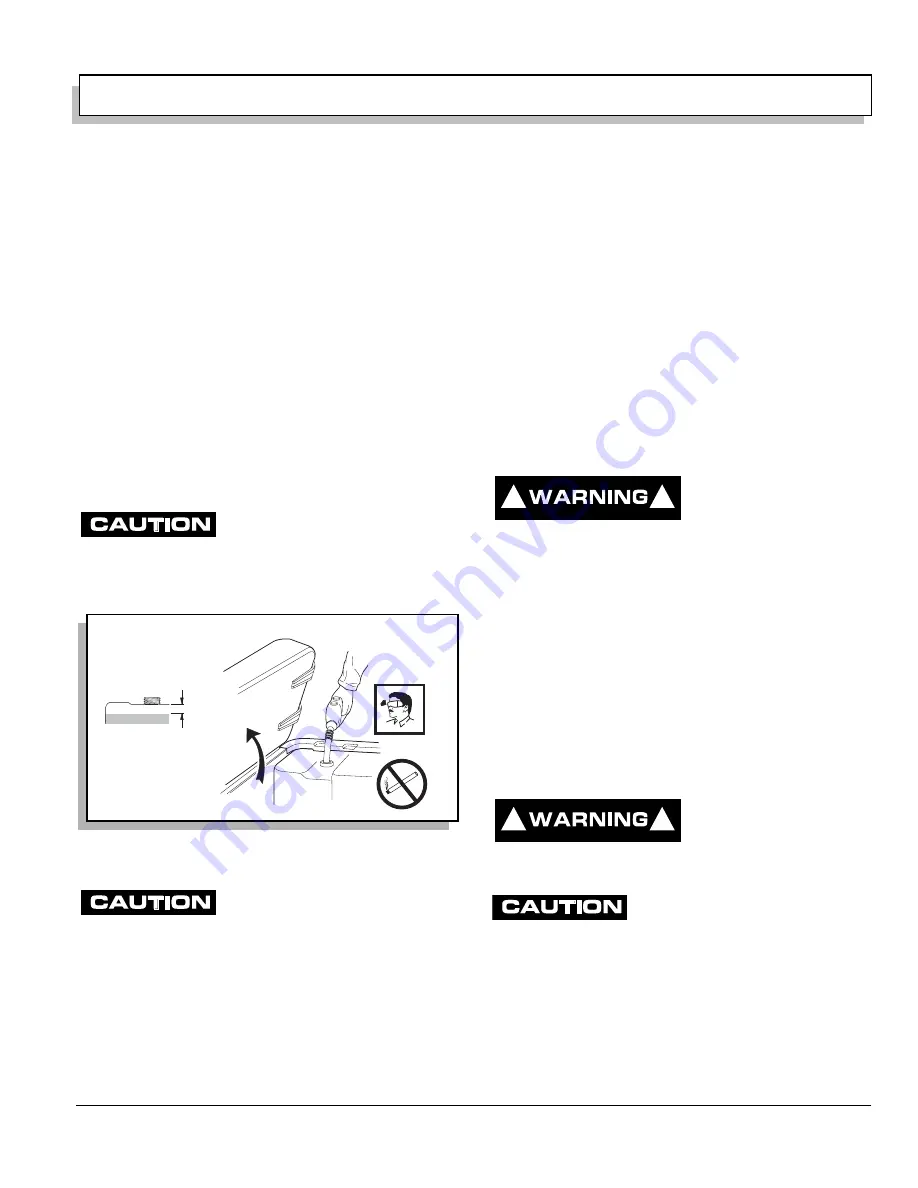
OPERATION AND SERVICE INFORMATION
Page 5
Owner’s Manual and Service Guide
Read all of manual to become thoroughly familiar with this vehicle. Pay particular attention to all Notes, Cautions and Warnings
Do not smoke near the fuel tank.
Do not refuel near open flame or electrical items which
could produce a spark.
Always handle gasoline in a well ventilated area.
Always wear eye protection to protect against
splashed fuel and fuel vapors.
Always allow adequate space for the expansion of
gasoline. Leave at least 1" (2.5 cm) space below
bottom of filler neck.
Inspect fuel cap, tank and other components for leaks
or deterioration that could cause a hazardous
condition.
The fuel tank is located under the seat on the passenger
side of the vehicle (Ref. Fig. 8 on page 5). Fill the tank with
fresh, clean, automotive grade gasoline (Ref. Fig. 39 on
page 22). High altitude or heavy use/load applications may
benefit from higher octane gasoline.
Do not use gasoline which contains Methanol.
Some fuels, called oxygenated or
reformulated gasoline, are gasoline blended
with alcohols or ethers. Excessive amounts of
these blends can damage the fuel system or cause performance problems.
If any undesirable operating symptoms occur, use gasoline with a lower
percentage of alcohol or ether.
BATTERY
Excessive use of accessories may drain
the battery and leave insufficient reserve
to start the vehicle.
The vehicle uses a combination starter/generator to both
start the engine and charge the battery. The engine will not
idle; therefore, the battery cannot be charged while the
vehicle is stopped. Do not operate accessory items (such as
accessory lights, radios, winch, etc.) excessively while the
vehicle is stopped.
The generator is capable of supplying 35 amps; therefore,
operation of all accessories could result in the discharge of
the battery even though the engine is running and the
generator operating. Discharging the battery is known as
deep cycling. The battery is not a deep cycle model, but is a
starting battery. Multiple deep cycling will result in the
premature failure of the battery.
If the vehicle battery has become discharged, it must be
charged using a 12 Volt charger that is rated at 10 amps or
less and in accordance with all instructions provided by the
manufacturer of the charger.
LABELS AND PICTOGRAMS
Vehicles may be labeled with pictograms as a method of
conveying information or warnings. Appendix A illustrates
and explains pictograms that may appear on the vehicle.
Not all pictograms shown in Appendix A will be found on
your vehicle.
SUN TOP AND WINDSHIELD
T h e s u n t o p d o e s n o t
provide protection from roll
over or falling objects.
The windshield does not provide protection from tree
limbs or flying objects.
The sun top and windshield provide some protection from
the elements; however, they will not keep the operator and
passenger dry in a downpour. This vehicle is not equipped
with seat belts and the sun top has not been designed to
provide roll over protection. In addition, the sun top does not
protect against falling objects nor does the windshield
protect against flying objects and tree limbs. Keep arms and
legs inside of vehicle while it is moving.
VEHICLE CLEANING AND CARE
VEHICLE CLEANING
To reduce the possibility of
severe injury or vehicle
d a m a g e , r e a d a n d
understand all instructions
supplied by manufacturer of pressure washer.
When pressure washing exterior of
vehicle, do not use pressure in excess of
700 psi. To reduce the possibility of
cosmetic damage, do not use any abrasive or reactive solvents to
clean plastic parts.
It is important that proper techniques and cleaning materials
be used. Using excessive water pressure may cause severe
injury to operator or bystander, damage to seals, plastics,
seat material, body finish or electrical system. Do not use
pressure in excess of 700 psi to wash exterior of vehicle.
Fig. 8 Fueling
1" Min.
(2.5 cm)
Fuel
Ref Ftl 1
!
!
!
!
Summary of Contents for FREEDOM
Page 8: ...Page vi Owner s Manual and Service Guide TABLE OF CONTENTS Notes...
Page 11: ...Owner s Manual and Service Guide SAFETY INFORMATION Page ix...
Page 12: ...Owner s Manual and Service Guide SAFETY INFORMATION Page x Notes...
Page 45: ...Page 25 GENERAL SPECIFICATIONS Owner s Manual and Service Guide GENERAL SPECIFICATIONS...
Page 56: ...Page 36 Owner s Manual and Service Guide GENERAL SPECIFICATIONS Notes...
Page 57: ...Page 37 Owner s Manual and Service Guide WARRANTY LIMITED WARRANTIES...
Page 66: ...Page 46 Owner s Manual and Service Guide EMISSION WARRANTY CALIFORNIA Notes...
Page 68: ...Page 48 Owner s Manual and Service Guide DECLARATION OF CONFORMITY...
Page 70: ...Page 50 Owner s Manual and Service Guide DECLARATION OF CONFORMITY Notes...
Page 71: ...Appendix A 1 LABELS AND PICTOGRAMS Owner s Manual and Service Guide LABELS AND PICTOGRAMS...
Page 84: ...Page vi Manuel d exploitation et d entretien TABLE DES MATIERES Remarques...
Page 88: ...Manuel d exploitation et d entretien CONSIGNES DE SECURITE Page x Remarques...
Page 125: ...Page 25 SPECIFICATIONS GENERALES Manuel d exploitation et d entretien SPECIFICATIONS GENERALES...
Page 136: ...Page 36 Manuel d exploitation et d entretien SPECIFICATIONS GENERALES Remarques...
Page 137: ...Page 37 Manuel d exploitation et d entretien GARANTIE GARANTIES LIMITEES...
Page 146: ...Page 46 Manuel d exploitation et d entretien GARANTIE DU CONTROLE D EMISSION CALIFOR Notes...
Page 148: ...Page 48 Manuel d exploitation et d entretien DECLARATION DE CONFORMITE...
Page 150: ...Page 50 Manuel d exploitation et d entretien DECLARATION DE CONFORMITE Remarques...









































